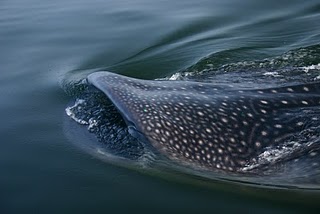Putting the world's commercial ships to work
 Monday, January 24, 2011 at 11:56AM
Monday, January 24, 2011 at 11:56AM The University of Miami’s Peter Ortner calls the Royal Caribbean cruise ship Explorer of the Seas” the world’s most luxurious research vessel”. That’s because he and his colleagues affixed instrument packages and even built a small lab on the luxury liner. Why do this? Well, if you think about it, cruise ships and commercial ships are criss-crossing the oceans all the time. What an awesome opportunity to collect data!
 Commercial shipping lanes of the world - the ultimate scientific transects?
Commercial shipping lanes of the world - the ultimate scientific transects?
One of the best sorts of data that Peter’s team collects is called ADCP, for Acoustic Doppler Current Profiling. Its a sonar method of sorts, but not for measuring the distance to the bottom. Instead, it can tell you the direction and strength of the current (i.e. its vector) at every depth under the ship. That’s because the speed that sound travels through the water is distorted by current the same way that the speed of sound through air is distorted by speed (you hear this as, for example, the change in pitch when an ambulance goes by).
 ADCP current vectors (black arrows) recorded by a ship and mapped on temperature of the Gulf Stream. You can see how well they match up
ADCP current vectors (black arrows) recorded by a ship and mapped on temperature of the Gulf Stream. You can see how well they match up
By putting a bunch of ADCPs on a bunch of different ships that cruise regular paths, oceanographers can build up a very detailed picture of currents across ocean basins, on a scale that individual oceanographic vessels could never match. Along the way, they have discovered new features, especially eddies of various sorts in some unexpected places. An eddy is a circular current, sort of like a gentle cyclone in water; sometimes they form by themselves, but more often they spin off the edge of a current as it passes through another body of water; these are called frontal eddies. Eddies can go clockwise or anti-clockwise and they can have a warm core or a cold core or a ring-like structure, depending on how they form. Eddies are important because they profoundly affect the biology within them - either stimulating or dampening productivity. They can also be really important for weather and climate, because an eddy can take a lot of heat energy from a warm current like, say, the Gulf Stream, and move it somewhere else. Climate and weather prediction models work much better when eddies are properly accounted for.
 What an eddy looks like by ADCP. The ship travels left to right across the top. Red pixels is where water is coming towards you out of the screen, while blue is it going away from you, into the screen
What an eddy looks like by ADCP. The ship travels left to right across the top. Red pixels is where water is coming towards you out of the screen, while blue is it going away from you, into the screen
 ADCP also gives you BIOLOGICAL data. Here, backscatter shows variations in the distribution of plankton as the ship crosses an eddy like the one in the previous figure
ADCP also gives you BIOLOGICAL data. Here, backscatter shows variations in the distribution of plankton as the ship crosses an eddy like the one in the previous figure
The idea of using commercial ships to collect oceanographic data has proven popular and now a UN committee is working on an implementation plan that would see many ships constantly gathering oceanographic data in all the oceans of the world. That program is called Oceanscope, and when it reaches maturity, Peter’s dream would have become and reality and he can kick back and watch the data roll in.
 3 Comments |
3 Comments |  Email Article | tagged
Email Article | tagged  Abrolhos,
Abrolhos,  NOAA,
NOAA,  Physics,
Physics,  Stony Brook,
Stony Brook,  U. Miami,
U. Miami,  currents,
currents,  oceanography
oceanography 












